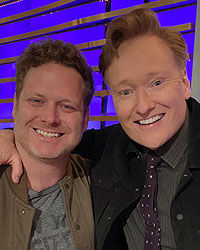Connect
Returning to the Night Shift
From hosts’ backyards, garages, and iPhones, late-night writers keep the show running.
For a month now, writers of late-night shows have been back at it, making studio audience talk show comedy without in-person writers’ rooms, access to sets, professional equipment—or the studio audiences themselves. These days, the constant ebb and flow that results in a late-night show going live-to-tape is unfolding over so many individual laptops on yet another day of pandemic-induced social distancing.
Lauren Greenberg, head writer of The Late Late Show with James Corden; Matt Gunn, a longtime writer on Real Time with Bill Maher; and Matt O’Brien, head writer at Conan, spoke with Connect about the experience thus far. All three had last seen the inside of their respective studios the week of March 9 (when they last saw their fellow writers in person, as well). Each is grappling with the newly fractured nature of the workflow and how to maintain the feeling of a collective with everyone sequestered in their own homes.
Lauren Greenberg (The Late Late Show with James Corden)
 For several hectic days after their last in-studio show on Thursday, March 13, the plan was to relocate The Late Late Show to a socially distanced green room. Then, CBS Television City shut down. On April 13, The Late Late Show re-emerged in its regular 12:30 a.m. time slot—from the host’s garage, set-dressed to evoke a Corden-esque man cave with a bit of neon, display of LPs, and glass jars of sweets. The host was lit with borrowed studio lights, while his sidekick and musical director Reggie Watts appeared in pixels.
For several hectic days after their last in-studio show on Thursday, March 13, the plan was to relocate The Late Late Show to a socially distanced green room. Then, CBS Television City shut down. On April 13, The Late Late Show re-emerged in its regular 12:30 a.m. time slot—from the host’s garage, set-dressed to evoke a Corden-esque man cave with a bit of neon, display of LPs, and glass jars of sweets. The host was lit with borrowed studio lights, while his sidekick and musical director Reggie Watts appeared in pixels.
What pieces of the show would translate? “James is such a performer, and he’s so great with an audience, it was interesting to think about that,” Greenberg says. “Obviously, monologues are different in the garage. A) Because he doesn’t have an audience and it’s really weird to just tell jokes to no one. B) No one really wants to hear about Trump right now. His press conferences are bullshit, it’s not funny right now.”
“Carpool Karaoke” was a nonstarter, but newly invented games with guests were doable. The “Shirt-Off Shootout Challenge,” an invention of co-head writer Ian Karmel, has house-bound NBA stars stripping off multiple layers of clothing and tossing them at a laundry bin for the charity Feed the Children. The guessing game “Pants or PJs” is somewhat self-explanatory, and the segment “Three Things to Cheer You Up” replaced the monologue.
Greenberg’s days are spent in Zoom rooms. The “studio Zoom” means Corden’s garage. The Late Late Show has 11 writers; Greenberg credits executive producers Rob Crabbe and Ben Winston for holding daily meetings with the young staff during the transition, and bringing in industry guest speakers like Friends co-creator David Crane to keep everyone engaged.
As for the host: “He’s exactly who he is,” Greenberg says. “He’ll open up and be emotional with us.”
Matt O’Brien, (Conan)
 If, in the future, there is a Zoom-y award for comedy, Conan scored big with a segment in which the host Zoom-bombed a staff meeting at a software company called TIBCO (José Arroyo, a Conan writer, has a brother who works there).
If, in the future, there is a Zoom-y award for comedy, Conan scored big with a segment in which the host Zoom-bombed a staff meeting at a software company called TIBCO (José Arroyo, a Conan writer, has a brother who works there).
Unlike Corden and Maher, Conan O’Brien does his show into an iPhone. “We felt like the spirit of these shows is bare bones and DIY, so we just sent him a little ring light and a little tripod for his iPhone,” says Matt O’Brien (no relation).
Essentially, Conan has transferred its more improv-based, found comedy aesthetic to a room in the host’s home. Conan—whose TBS show scaled back to 30 minutes last year—has become more digitally oriented over the years, with a popular podcast “Conan O’Brien Needs a Friend” and nearly 8 million subscribers to the Team Coco YouTube channel.
In this way, the at-home show is more a patchwork of collected material than a linear experience live-to-tape. “Before everything got shut down, we did a run on our prop room and tried to put as much as we could in Conan’s garage,” Matt O’Brien says. The haul included a Jesus beard—“We knew we’d probably want to talk to Jesus during Easter”—35 beach balls, and some fake swords.
There is an 11 a.m. writers’ meeting, “but that can change. You’re sort of on call, if you will, all the time, to figure out things logistically or creatively.” Ultimately, O’Brien says, “you’re at the mercy of what the editor’s home computers can do, how fast their connection can upload or download content.” Bandwidth matters for the writers too, since they produce their own segments, and Conan himself is shooting and uploading material.
“Conan is the one missing the audience the most,” O’Brien says. “As a performer you don’t get that feedback. It can be tough to adjust to that new reality. I think we’ll keep doing it this way as long as we can to keep people employed. And it is an opportunity to keep messing around creatively to new circumstances.”
Matt Gunn, (Real Time with Bill Maher)
 Real Time has gone al fresco and even pastoral; Maher has his socially distanced director and executive producer on hand. “He had strong feelings about doing it outside,” Gunn says. “Even the day it was raining he wanted to do it outside.”
Real Time has gone al fresco and even pastoral; Maher has his socially distanced director and executive producer on hand. “He had strong feelings about doing it outside,” Gunn says. “Even the day it was raining he wanted to do it outside.”
Maher has the soul—and the mileage—of a comedian: The monologue lives on, with a laugh track and cutaways to studio audiences of yore. As for the jokes themselves, “now there are really two topics,” Gunn says. “The first half of the monologue is jokes about him being bored at home. And then everything with the coronavirus and Trump’s press conferences. Trump is always such an embarrassment of riches for the monologues.”
Normally taped live on Fridays, Real Time is now shot over a period of hours on Thursdays. Stingingly, losing Friday rewrites came with a price last week, when Trump chose the end of the week to float his home remedy for COVID-19.
Gunn has written for Real Time for 16 seasons; by his reckoning, that only makes him fifth in seniority on the staff. “It’s a very well-oiled machine after all these years,” he says. More than anything, Gunn misses the daily 1 p.m. meetings, with Maher at the head of the table, with his cards. The host curates hundreds of submitted monologue jokes down to 10 or 15. Similarly, dozens of “New Rules” become five. “We usually have that Thursday rehearsal, where he might do 15 to 20 ‘New Rules,’ and the audience tells you which ones they like the most,” Gunn says. “Now, without an audience, he’s just gonna pick the four or five he likes.”
